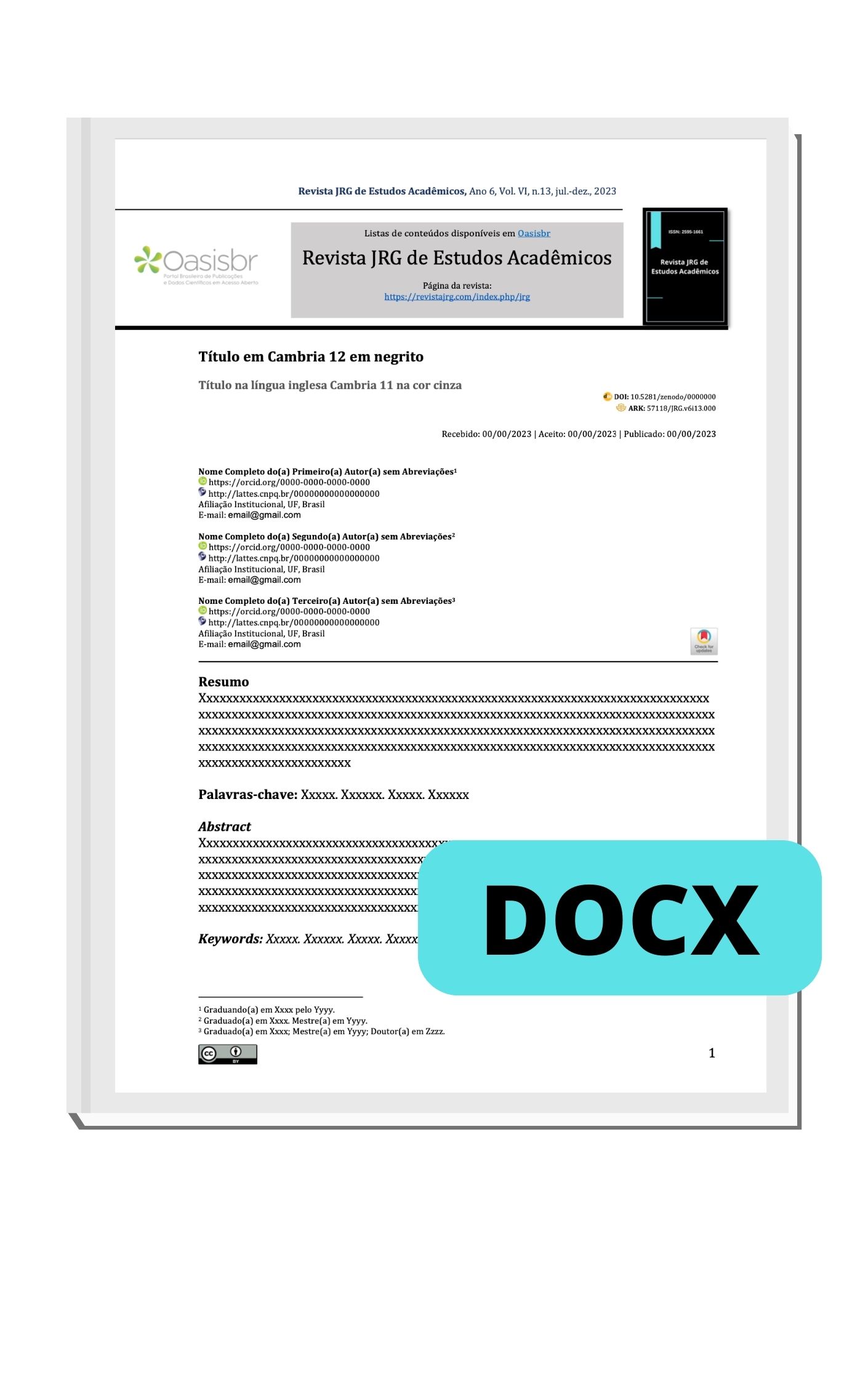Vulvovaginites recorrentes: hábitos, produtos de higiene, comportamentos e fatores relacionados, uma revisão integrativa do período de 2014 a 2023
DOI:
https://doi.org/10.55892/jrg.v8i19.2523Palabras clave:
Vulvovaginite, Recidiva, Produtos de Higiene Feminina, Saúde Reprodutiva, Saúde da MulherResumen
Introdução: Dentre as queixas mais frequentes entre mulheres em idade reprodutiva, o corrimento, o ardor e o prurido vaginal, merecem destaque. Esses sintomas, principalmente associados às vulvovaginites (VV), impactam diretamente a vida de pacientes com quadros de recorrência, de modo a provocar desconforto, gerar gastos, comprometer tarefas, relacionamentos e potencializar sentimentos negativos. Infelizmente, a assistência em saúde, sobretudo quando se fala em cuidado com a genitália feminina, envolve diversos tabus, o que dificulta elucidar os aspectos que podem estar associados à recorrência. Objetivo: Analisar hábitos, produtos de higiene, comportamentos e fatores que podem estar relacionados à ocorrência e recidiva de VV. Metodologia: Revisão integrativa da literatura com artigos entre 2014 e 2023, nas bases de dados SCIELO, PUBMED e BVS. Utilizou-se uma combinação de descritores nos idiomas português, inglês e espanhol. Resultados e discussão: Foram selecionados 13 artigos para compor a presente revisão. Observou-se que a condição socioeconômica, quando interfere na obtenção de conhecimento, e o estilo de vida moderno, com pouco tempo de cuidado, predispõem mulheres a desenvolverem VV. Dentre os hábitos que podem contribuir para esse desequilíbrio, pode-se citar a limpeza excessiva da região; a prática de duchas vaginais; o uso de absorventes não respiráveis, sabonetes íntimos e produtos como desodorantes; as vestimentas justas; os tipos de calcinhas e a depilação íntima. Quanto aos comportamentos sexuais, os parceiros podem atuar como reservatório de Candida e o sexo anal, quando há transporte de material fecal, pode favorecer o risco de infecções. Outros fatores ainda exigem maior investigação. Considerações finais: Muitos dos hábitos prejudiciais citados fazem parte do cotidiano de mulheres com VV. Assim, é fundamental que sejam informadas sobre os riscos de determinadas práticas. Cabe aos profissionais de saúde a promoção de educação para prevenção e controle dessa enfermidade, com uma abordagem personalizada sobre mudanças em práticas de cuidado.
Descargas
Citas
AKIMOTO-GUNTHER, L. et al. Highlights Regarding Host Predisposing Factors to Recurrent Vulvovaginal Candidiasis: Chronic Stress and Reduced Antioxidant Capacity. PloS one, v. 11, n. 7, p. e0158870, 2016. DOI:10.1371/journal.pone.0158870.
ALVES, G. B. et al. Perfil etiológico e epidemiológico das vulvovaginites que acometem mulheres em uma cidade do estado de Tocantins. Revista Eletrônica Acervo Saúde, v. 13, n. 2, p. e5383, 2021. DOI: 10.25248/reas.e5383.2021.
ANJOS, G. dos et al. Aspectos da abordagem terapêutica sobre candidíase vulvovaginal. Arquivos de Ciências da Saúde da UNIPAR, v. 27, n. 3, p. 1284–1306, 2023. DOI: 10.25110/arqsaude.v27i3.2023-015.
BAGNALL P.; RIZZOLO D. Bacterial vaginosis: a practical review. Journal of the American Academy of Physician Assistants, v. 30, n. 12, p. 15-21, 2017. DOI: 10.1097/01.JAA.0000526770.60197.fa.
BARDIN, M. G. et al. Hábitos de Higiene Genital e Atividade Sexual entre Mulheres com Vaginose Bacteriana e/ou Candidíase Vulvovaginal. Revista Brasileira de Ginecologia e Obstetrícia, v. 44, n. 2, p. 169–177, 2022. DOI: 10.1055/s-0041-1741536.
BILARDI, J. E. et al. Women view key sexual behaviours as the trigger for the onset and recurrence of bacterial vaginosis. Plos one, v. 12, n. 3, p. e0173637, 2017. DOI: 10.1371/journal.pone.0173637.
BOATTO, H. F. et al. O papel dos parceiros sexuais sintomáticos e assintomáticos nas vulvovaginites recorrentes. Revista Brasileira de Ginecologia e Obstetrícia, v. 37, n. 7, p. 314–318, 2015. DOI: 10.1590/S0100-72032015000509.
BONATO, F. et al. Infecção do trato urinário por leveduras do gênero Candida – revisão de literatura. Arquivos de Ciências da Saúde da UNIPAR, v. 26, n. 3, 2022. DOI: 10.25110/arqsaude.v26i3.2022.8996. Disponível em: https://revistas.unipar.br/index.php/saude/article/view/8996. Acesso em: 18 set. 2024.
BRASIL. Ministério da Saúde. Protocolo clínico e diretrizes terapêuticas para atenção integral às pessoas com infecções sexualmente transmissíveis (IST). Brasília: Ministério da Saúde; 2022. Disponível em: http://www.aids.gov.br/pt-br/pub/2015/protocolo-clinico-e-diretrizes-terapeuticas-para-atencao-integral-pessoas-com-infeccoes. Acesso em: 19 fev. 2024.
BROWN, L. et al. Compliance with the Updated BASHH Recurrent Vulvovaginal Candidiasis Guidelines Improves Patient Outcomes. Journal of fungi, v. 8, n. 9, p. 924, 2022. DOI:10.3390/jof8090924.
CEZAR, J. et al. Elaboração de material didático para compreensão da anatomia genital feminina e peculiaridades na sua higienização. Arquivos do MUDI, v. 23, n. 3, p. 10-21, 2019. DOI: 10.4025/arqmudi.v23i3.51509.
CHEN, Y. et al. Role of female intimate hygiene in vulvovaginal health: Global hygiene practices and product usage. Women's Health, Londres, v. 13, n. 3, p. 58-67, 2017. DOI: 10.1177/1745505717731011.
CRANN, S. et al. Vaginal health and hygiene practices and product use in Canada: a national cross-sectional survey. BMC women's health, v. 18, n. 1, p. 52, 2018. DOI: 10.1186/s12905-018-0543-y.
FELIX, T. C. Vulvovaginite em mulheres atendidas em serviço de Atenção Primária à Saúde da Família: ocorrência e hábitos de higiene. 2019. 78 p. Dissertação (Mestrado em Ciências da Saúde) – Faculdade de Medicina, Universidade Federal de Uberlândia, 2019. DOI: 10.14393/ufu.di.2019.1247.
FERREIRA E.; SOUZA. T. Cuidados e higiene íntima feminina: agentes externos e consequências. Farmácia e promoção de saúde, Ponta Grossa, v. 2, p. 125–135, 2020. DOI: 10.22533/at.ed.25220030215.
GRINCEVICIENE, S. et al. Sexual behaviour and extra-genital colonisation in women treated for recurrent Candida vulvo-vaginitis. Mycoses, v. 61, n. 11, p. 857-860, 2018. DOI: 10.1111/myc.12825.
HOLDCROFT, A.; IRELAND, D.; PAYNE, M. The Vaginal Microbiome in Health and Disease-What Role Do Common Intimate Hygiene Practices Play?. Microorganisms, v. 11, n. 2, p. 298, 2023. DOI: 10.3390/microorganisms11020298.
IMAMURA, Y. et al. Association of Women's Health Literacy and Work Productivity among Japanese Workers: A Web-based, Nationwide Survey. Japan Medical Association Journal, v. 3, n.3, p. 232-239, 2020. DOI: 10.31662/jmaj.2019-0068.
KALIA, N.; SINGH, J.; KAUR, M. Microbiota in vaginal health and pathogenesis of recurrent vulvovaginal infections: a critical review. Annals of Clinical Microbiology and Antimicrobials, v. 19, n. 1, 19 p., 2020. DOI: 10.1186/s12941-020-0347-4.
LÓPEZ, M. et al. Hábitos higiénicos vulvo-vaginales de consultantes ambulatorias en gineco-obstetricia. Rev. chil. obstet. ginecol., v. 80, n. 4, p. 282-288, 2015. DOI: 10.4067/S0717-75262015000400002.
MCBRIDE, K. R. Examining Heterosexual Women’s Anal Sexual Health Knowledge and Product Use. The Journal of Sex Research, v. 56, n. 8, p. 1070–1082, 2018. DOI: 10.1080/00224499.2018.1467368.
MILHOMENS, P.M.; MACHADO, M.C.A.M.; MORAES, F.C.; BORGES, K.R.A.; DINIZ, M.R.F. Prevalência dos agentes etiológicos das vulvovaginites através de resultados de exames citopatológicos. Revista de Investigação Biomédica, São Luís, v. 6, p. 92-102, fev. 2014. DOI: 10.24863/rib.v6i1.11.
MURINA F., et al. Characterization of female intimate hygiene practices and vulvar health: A randomized double-blind controlled trial. Journal of Cosmetic Dermatology, v. 19, n. 10, p. 2721-2726, 2020. DOI: 10.1111/jocd.13402.
MURINA F., et al. The role of female intimate hygiene practices in the management of vulvovaginal candidiasis: A randomized, controlled open-label trial. Health Care Women International, v. 44, n. 5, p. 689-700, 2022. DOI: 10.1080/07399332.2022.2061972.
MURINA F., et al. Real-World Practices and Attitudes Towards Intimate Self- Care: Results From An International Women's Survey. Journal of Gynecology Obstetrics and Human Reproduction, v. 50, n. 10, p. 102192, 2021. DOI: 10.1016/j.jogoh.2021.102192.
NEVES J. J. et al. Alterações celulares reativas frente ao morfotipo de lactobacilos vaginais. Revista Brasileira de Análises Clínicas, 2019. DOI: 10.21877/2448-3877.201900793.
NUNES, R.D.; FRANÇA, C.O.; TRAEBERT, J.F. Prevalência de vulvovaginite na gravidez e sua relação com complicações perinatais. Arquivos Catarinenses de Medicina, Florianópolis, v. 47, n.1, p. 121-132, 2018. Disponível em: https://revista.acm.org.br/index.php/arquivos/article/view/293. Acesso em: 19 fev. 2024.
OLIVEIRA, J.; CARNEIRO, C. Fatores associados a alterações da microbiota no trato genital feminino inferior. Pensar Acadêmico, v. 18, n. 2, p. 289-299, 2020. Disponível em: http://www.repositorio.ufop.br/jspui/handle/123456789/13679. Acesso em: 12 fev. 2024.
PAGE, M. J. et al. A declaração Prisma 2020: diretriz atualizada para relatar revisões sistemáticas. BMJ, v.1; n. 71, p. 372, 2021. DOI: 10.1136/bmj.n71.
PALUDO, R.; MARIN. D. Relação entre candidíase de repetição, disbiose intestinal e suplementação com probióticos: uma revisão. Destaques Acadêmicos, Lajeado, v. 10, n. 3, p. 46-57, 2018. DOI: 10.22410/issn.2176-3070.v10i3a2018.1745
PEREIRA, L. et al. Vulvovaginal candidiasis and current perspectives: new risk factors and laboratory diagnosis by using MALDI TOF for identifying species in primary infection and recurrence. European journal of clinical microbiology & infectious diseases: official publication of the European Society of Clinical Microbiology, v. 40, n. 8, p. 1681-1693, 2021. DOI: 10.1007/s10096-021-04199-1.
PITOMBEIRA, D.; OLIVEIRA, L. Pobreza e desigualdades sociais: tensões entre direitos, austeridade e suas implicações na atenção primária. Ciência & Saúde Coletiva, v. 25, n. 5, p. 1699-1708, 2020. DOI: 10.1590/1413-81232020255.33972019.
PONTES, A. C. et al. A systematic review of the effect of daily panty liner use on the vulvovaginal environment. International journal of gynaecology and obstetrics: the official organ of the International Federation of Gynaecology and Obstetrics, v. 127, n. 1, p. 1-5, 2014. DOI: 10.1016/j.ijgo.2014.06.017.
ROLO, J. et al. Semen supports growth of Candida albicans: A putative risk factor for recurrence of vulvovaginal infections?. The journal of obstetrics and gynaecology research, v. 46, n. 9, p. 1893-1899, 2020. DOI: 10.1111/jog.14367.
ROMERO-GAMBOA, D. G. et al. Impact of genital hair removal on female skin microenvironment: barrier disruption and risk of infection, a literature review. Medicas UIS, Bucaramanga, v. 3, p. 27-33, 2019. Disponível em: http://www.scielo.org.co/scielo.php?script=sci_arttext&pid=S0121-03192019000300027&lng=en&nrm=iso. Acesso em: 21 fev. 2024.
RUIZ, C. et al. Daily genital cares of female gynecologists: a descriptive study. Revista da Associação Médica Brasileira, v. 65, n. 2, p. 171-176, 2019. DOI: 10.1590/1806-9282.65.2.171.
SANTOS, A. Relevância dos cuidados e higiene íntima na qualidade de vida da mulher. 2021. 54 f. Trabalho de Conclusão de Curso (Graduação em Farmácia) – Faculdade de Educação e Meio Ambiente- FAEMA, 2021. Disponível em: https://repositorio.unifaema.edu.br/bitstream/123456789/2921/1/ALANA%20KRISTINA%20DE%20SOUZA%20SANTOS.pdf. Acesso em: 20 fev. 2024.
SCHALKWYK, J.; YUDIN, M. Vulvovaginitis: screening for and management of trichomoniasis, vulvovaginal candidiasis, and bacterial vaginosis. Journal of Obstetrics and Gynaecology Canada, Toronto, v. 37, n. 3, p. 266-274, 2015. DOI: 10.1016/S1701-2163(15)30316-9.
SAXON, C. et al. British Association for Sexual Health and HIV national guideline for the management of vulvovaginal candidiasis (2019). International Journal of STD & AIDS, v. 31, n. 12, p. 1124-1144, 2020. DOI:10.1177/0956462420943034.
SOBEL, J. Recurrent vulvovaginal candidiasis. American Journal of Obstetrics and Gynecology, v. 214, n. 1, p. 15-21, 2016. DOI: 10.1016/j.ajog.2015.06.067.
SOUTO, K.; MOREIRA, M. R. Política Nacional de Atenção Integral à Saúde da Mulher: protagonismo do movimento de mulheres. Saúde em Debate, v. 45, n. 130, p. 832–846, 2021. DOI: 10.1590/0103-1104202113020.
SOUZA, B.; OLIVEIRA, M.; GONÇALVES, J. Influências empíricas no cuidado íntimo da saúde da mulher na fase reprodutiva: riscos e consequências. Anais do fórum de iniciação científica do unifunec, v. 11, n. 11, 2020. Disponível em: https://seer.unifunec.edu.br/index.php/forum/article/view/5006. Acesso em:12 ago. 2024.
YANO, J. et al. Current patient perspectives of vulvovaginal candidiasis: incidence, symptoms, management and post-treatment outcomes. BMC women's health, vol. 19, n. 1, p. 48, 2019. DOI: 10.1186/s12905-019-0748-8.











































